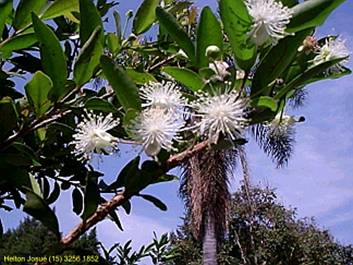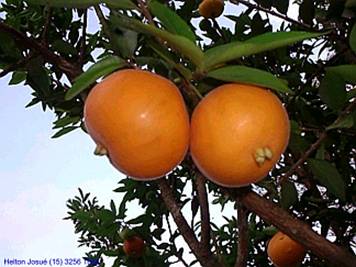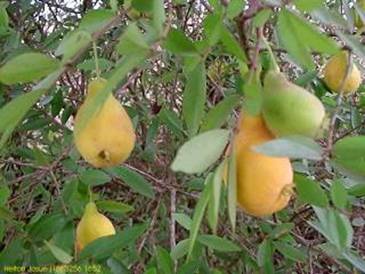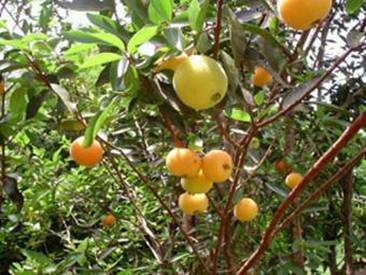EUGENIA PYRIFORMIS
FAMILIY OF MYRTACEAE
|
Flower |
Variety with large and sweet fruits |
|
Variety with pear-shaped fruits |
Variety with round fruits |
NOMENCLATURE AND IMPORTANCE: UVAIA comes from the Tupi, and means ”sour fruit”. Also known as Orvalha and Uvalha.
Origin: Comes from the Atlantic Rain Forest from São Paulo to Rio Grande do Sul, Brazil. More information in Portuguese at the link: http://floradobrasil.jbrj.gov.br/2012/index?mode=sv&group=Root_.Angiospermas_&family=Root_.Angiospermas_.Myrtaceae_&genus=Eugenia&species=&author=&common=&occurs=1®ion=&state=&phyto=&endemic=&origin=&vegetation=&last_level=subspecies&listopt=1
Features: Small tree, 4 to 12 metres high with a rounded or cup-shaped crown. 2 to 4 metres in diameter with a straight trunk, which is divided in most cases in several upright sticks of 10 to 50 cm in diameter, the bark is greenish-brown Longitudinal fissures that slough into thin plates in the spring. The leaves are opposite, simple, glabrous (hairless), slightly stiffer texture. The limb or leaf tissue is shaped lanceolate with blunt or rounded base and acute or pointed tip supplied (sharp ending point). They are 2.5 to 5.5 cm long and 0.6 to 1.4 cm wide, the petiole is 0.2 to 0.4 cm long. The flowers are hermaphrodite, axillary (growing out of the confluence of the leaf and budding shoots of the same year) under the stem or trunk, they are 1.4 to 2.2 cm long, cyclic (multiple cycles), with two cases. The bud is protected by 2 bracts (modified leaf type) and the shell (outer shell) consists of 4 free sepals, unequal and fluffy together. The corolla (inner shell) consists of four inverted egg-shaped, white and clearly formed petals.
Culture tips: An extremely adaptable plant can be grown in climates with annual temperatures between 18 and 26 degrees tolerated, does take frosts of down to -4 °C well, bearing fruit from sea level in Rio de Janeiro to altitudes of 1200 m in the forest area of Mineira. In its origin it rains 1200 to 1800 mm per year, grows well in many different types of soil, acidic, loamy or sandy, prefers particularly fertile and moist soils. The fruiting begins at age of 2 to 4 years depending on the variety.
Propagation: The seeds are round and creamy colored, unruly (lose their ability to germinate after 20 days). I recommend to sow 2 seeds directly into the individual bags with substrate with 50% soil and 50% organic material mixed well. Germination usually takes 40 to 60 days, and the seedlings reach 35 cm after 11 to 12 months after germination.
Planting: I recommend to plant in full sun at a distance of 4 x 4 m for uvaia pêra and uvaia doce and at a distance of 6 x 6 m and for Uvaia acida do mato. The holes should be 50 cm in three dimensions and with the organic mixture of 30% sand and 30% gravel material 30 cm below the surface to be filled. Leave it for 2 months, then plant best in the period from September to November, pour after planting with 10 liters of water, then pour every 15 days if it does not rain.
Culture: The plant grows quickly and requires no special care, but the surface should be covered with shredded material and weeds should be weeded so that the plant can not choke. Fertilize organic compost mixed with 2 kg of chicken manure and NPK 10-10-10 plus 30 grams. Distribute nutrients 5 cm below the surface within 20 cm from the trunk early October.
Use: Bear fruit in the months of September to November. The fruits are consumed in kind and in the form of juices. The fruit has great potential for the production of fermented beverages such as wine and good vinegar. The pulp can produce delicious ice cream.
BUY THE BOOK “COLECIONANDO FRUTAS”
Back to the seedlist (English) or back to Myrtaceae (Portuguese)



